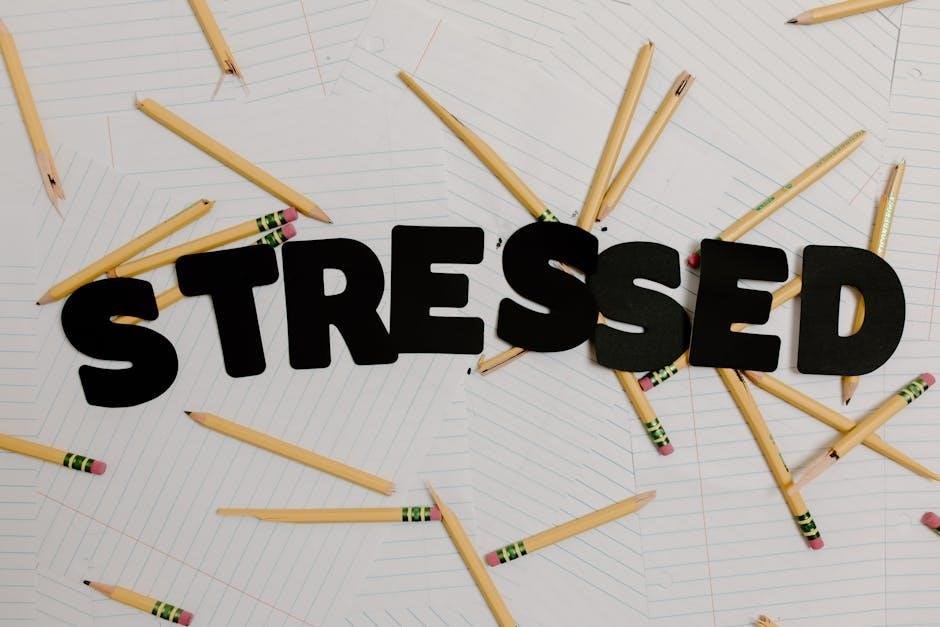
treatment plan for adjustment disorder pdf
Adjustment disorder is a stress-related condition triggered by significant life events or changes. It involves emotional and behavioral symptoms, such as mood swings and social withdrawal. A tailored treatment plan is essential, combining psychotherapy and lifestyle modifications to support recovery and adaptability. Early intervention and personalized strategies are key to addressing the challenges posed by this condition, ensuring effective management and improved quality of life.
1.1 Definition and Overview
Adjustment disorder (AD) is a stress-related mental health condition triggered by significant life events or changes. It is characterized by emotional and behavioral symptoms, such as sadness, hopelessness, or social avoidance, that develop within three months of a stressor. AD is marked by a disproportionate response to the stressor, impairing daily functioning. It is distinct from other disorders due to its direct link to identifiable stressors. The condition can vary in severity and presentation, with symptoms often resolving once the stressor is removed or coped with. Understanding AD is crucial for developing effective treatment plans tailored to individual needs, promoting recovery and resilience. Early intervention is key to managing symptoms and improving quality of life.
1.2 Prevalence and Demographics
Adjustment disorder (AD) is relatively common, affecting individuals across various demographics. Studies suggest that approximately 5-20% of the general population may experience AD at some point in their lives. It occurs equally in males and females, though specific subtypes may vary by gender. AD can affect all age groups, including children and the elderly, with prevalence rates influenced by exposure to stressors. Certain populations, such as those in high-stress occupations or undergoing significant life changes, are at higher risk. Recognizing these patterns aids in early identification and tailored interventions, enhancing the effectiveness of treatment plans for diverse groups. Understanding demographics helps clinicians address unique needs and improve outcomes.
1.3 Importance of a Treatment Plan
A well-structured treatment plan is crucial for managing adjustment disorder, as it provides a clear roadmap for recovery. By addressing specific symptoms and stressors, the plan ensures targeted interventions, improving emotional and functional outcomes. Regular reviews and updates allow clinicians to adapt strategies based on progress, enhancing effectiveness. A comprehensive plan also fosters collaboration between patients and healthcare providers, promoting engagement and adherence. Ultimately, a personalized treatment plan helps individuals develop coping skills and resilience, reducing the risk of relapse and improving overall quality of life. This structured approach is essential for addressing the unique challenges of adjustment disorder and achieving long-term recovery.

Diagnostic Criteria for Adjustment Disorder
Adjustment disorder involves emotional or behavioral symptoms triggered by a stressor, occurring within three months of the event, with reactions exceeding expected levels and not meeting criteria for other disorders.
2.1 ICD-10 Classification (F43.21)
In the ICD-10, Adjustment Disorder with Depressed Mood is classified under F43.21. This code specifies a mental health condition where emotional or behavioral symptoms develop in response to an identifiable stressor. The diagnosis requires symptoms to occur within three months of the stressor and not persist beyond six months after its resolution. F43.21 is distinct from other mood disorders, such as major depressive disorder, as it is directly linked to a specific stressor. Accurate classification is crucial for developing targeted treatment plans, ensuring proper documentation, and facilitating effective communication among healthcare providers. This code underscores the importance of identifying stressor-related symptoms in diagnostic processes.
2.2 Key Symptoms and Characteristics
Adjustment Disorder is characterized by emotional or behavioral symptoms in response to identifiable stressors. Common symptoms include sadness, hopelessness, and avoidance behaviors, which interfere with daily life. These symptoms typically develop within three months of the stressor and do not persist beyond six months after its resolution. The condition is marked by a disproportionate response to the stressor, distinguishing it from normal reactions. Symptoms may also include irritability, anxiety, or feelings of being overwhelmed. The presence of these characteristics is essential for diagnosis, as they highlight the emotional and functional challenges individuals face when adapting to significant life changes or stressors.
2.3 Differentiating from Other Disorders
Differentiating adjustment disorder from other mental health conditions is crucial for accurate diagnosis. Unlike major depressive disorder, adjustment disorder is directly linked to a specific stressor and typically resolves once the stressor is removed. It is also distinct from anxiety disorders, as its symptoms are more focused on emotional reactivity rather than pervasive fear or avoidance. A thorough mental health evaluation is necessary to rule out other conditions, such as post-traumatic stress disorder (PTSD) or personality disorders. The key criterion for adjustment disorder is the presence of emotional or behavioral symptoms that develop in response to a identifiable stressor, making it essential to assess the timing and nature of the stressor relative to symptom onset.

Psychological Treatment Approaches
Psychological treatment approaches for adjustment disorder include Cognitive-Behavioral Therapy (CBT), psychodynamic therapy, and supportive therapy. These methods help patients understand stressors, develop coping strategies, and improve emotional resilience.
3.1 Cognitive-Behavioral Therapy (CBT)
Cognitive-Behavioral Therapy (CBT) is a widely used approach for treating adjustment disorder, focusing on identifying and modifying negative thought patterns and maladaptive behaviors. By restructuring distorted or unhelpful beliefs, individuals develop healthier coping strategies. CBT emphasizes problem-solving skills and practical techniques to manage stressors effectively. Behavioral activation and exposure exercises are often incorporated to reduce avoidance and improve functioning. This structured, goal-oriented therapy helps patients regain control over their emotions and actions, fostering resilience and adaptability. Regular practice of CBT techniques enhances long-term emotional well-being, making it a cornerstone of adjustment disorder treatment plans.
3.2 Psychodynamic Therapy
Psychodynamic therapy focuses on exploring unconscious feelings and past experiences that may influence current reactions to stressors. This approach helps individuals gain insight into how unresolved conflicts or unprocessed emotions contribute to their adjustment disorder. By examining these underlying issues, patients develop a deeper understanding of their emotional responses and behaviors. The therapy encourages emotional expression and processing, fostering self-awareness and personal growth. It also aims to enhance coping mechanisms and improve relationships, which are critical for managing adjustment difficulties. Psychodynamic therapy is particularly effective for individuals who benefit from exploring the root causes of their distress, promoting long-term emotional resilience and adaptation.
3.3 Supportive Therapy
Supportive therapy is a non-directive approach that emphasizes emotional support and validation. It focuses on providing a safe environment where individuals feel understood and accepted, helping them cope with stressors and emotional distress. This therapy aims to enhance self-esteem, reduce feelings of isolation, and promote a sense of control over their lives. Techniques include active listening, empathy, and encouragement, enabling patients to express their concerns and feelings openly. Supportive therapy is particularly beneficial for individuals who may not respond well to more structured approaches, offering a flexible and comforting framework to address their adjustment disorder and improve their overall mental well-being.

Pharmacological Interventions
Pharmacological interventions for adjustment disorder may include SSRIs like fluoxetine or sertraline to alleviate depressive or anxiety symptoms. Medications are often used alongside psychotherapy for optimal results.
4.1 Role of SSRIs (e.g., Fluoxetine, Sertraline)
SSRIs, such as fluoxetine and sertraline, are commonly prescribed for adjustment disorder to manage symptoms like depression and anxiety. These medications work by increasing serotonin levels in the brain, improving mood and reducing emotional distress. They are often recommended when symptoms are severe or persistent. SSRIs are typically well-tolerated and can be combined with psychotherapy for enhanced effectiveness. Regular monitoring by a healthcare provider is essential to assess progress and adjust dosages as needed. While SSRIs do not cure adjustment disorder, they play a crucial role in alleviating symptoms and facilitating recovery.
4.2 Other Medications and Considerations
Beyond SSRIs, other medications may be considered for adjustment disorder, such as SNRIs (e.g., venlafaxine) or benzodiazepines for short-term anxiety relief. Benzodiazepines, like alprazolam, are typically used cautiously due to dependency risks. Beta-blockers (e.g., propranolol) can help manage physical symptoms like tremors or palpitations. Medications are often selected based on symptom severity and patient history. For instance, SNRIs may be preferred if SSRIs are ineffective. It’s crucial to avoid medications that could worsen symptoms or interact with other treatments. Decisions are made collaboratively between the patient and clinician, ensuring safety and efficacy. These medications are typically adjuncts to psychotherapy and lifestyle changes, not standalone solutions.
4.3 Medication Management and Monitoring
Medication management for adjustment disorder requires a structured approach to ensure safety and efficacy. Regular follow-ups with the treating clinician are essential to monitor symptom improvement and side effects. The frequency of monitoring depends on the patient’s condition, typically starting with weekly or bi-weekly visits. Doses may be adjusted based on response, and medications are tapered off gradually when symptoms stabilize. Patients should be educated about potential side effects and the importance of adhering to the prescribed regimen. Open communication between the patient and clinician is key to addressing concerns and optimizing treatment outcomes. This collaborative process ensures personalized care and minimizes risks.

Lifestyle Modifications and Coping Strategies
Lifestyle changes and coping strategies play a crucial role in managing adjustment disorder. Regular exercise, mindfulness practices, and maintaining a balanced diet can improve emotional resilience. Engaging in activities that promote relaxation and social connection helps individuals adapt to stressors more effectively. Structured routines and time management techniques can also enhance overall well-being and facilitate recovery.
5.1 Stress Management Techniques
Stress management techniques are essential for addressing adjustment disorder, as they help individuals cope with triggers and reduce emotional distress. Deep breathing exercises, progressive muscle relaxation, and mindfulness meditation are effective methods to calm the mind and body. Journaling and grounding techniques can also provide clarity and emotional release. Regular physical activity, such as yoga or walking, enhances mood and reduces tension. These strategies, when practiced consistently, empower individuals to handle stressors more effectively, fostering resilience and improving overall well-being. Incorporating these techniques into a treatment plan can lead to significant improvements in managing adjustment disorder symptoms and adapting to challenging situations.
5.2 Mindfulness and Relaxation Practices
Mindfulness and relaxation practices are integral to managing adjustment disorder, fostering emotional resilience and reducing stress. Techniques such as mindfulness meditation, yoga, and deep breathing exercises help individuals stay present and alleviate anxiety. These practices encourage a non-judgmental awareness of thoughts and emotions, promoting emotional regulation. Regular engagement in mindfulness activities can enhance self-awareness, reduce emotional reactivity, and improve overall well-being. By incorporating these practices into a treatment plan, individuals can better navigate life challenges and cultivate a sense of calm and stability. Consistent practice leads to improved emotional resilience, empowering individuals to manage stressors more effectively and maintain a healthier mental state.
5.3 Importance of Social Support
Social support plays a crucial role in the treatment of adjustment disorder, as it provides individuals with emotional and practical assistance during challenging times. Family, friends, and support groups can offer encouragement, understanding, and help in navigating daily responsibilities. Strong social connections reduce feelings of isolation and enhance resilience, enabling individuals to cope more effectively with stressors. Involving caregivers and loved ones in the treatment plan fosters a supportive environment that promotes recovery. Encouraging open communication and active participation from the social network can significantly improve an individual’s ability to adapt and manage their condition, leading to better overall mental health outcomes.

Monitoring and Adjusting the Treatment Plan
Regular monitoring of progress is essential. Treatment plans are reviewed every 3-6 months to update goals, interventions, and strategies, ensuring effectiveness and adaptability to patient needs.
6.1 Regular Progress Assessments
Regular progress assessments are vital for tracking improvement and identifying barriers. These assessments involve evaluating symptom severity, functional status, and the patient’s adherence to the treatment plan. Clinicians use standardized tools and patient feedback to gauge progress. Adjustments are made based on the patient’s response, ensuring the plan remains effective. This continuous process helps in addressing emerging challenges and celebrating successes, fostering a collaborative approach between the patient and clinician. Regular assessments also guide decision-making, ensuring the treatment aligns with the patient’s evolving needs and goals.
6.2 Updating Goals and Objectives
Updating goals and objectives is a dynamic process that ensures the treatment plan remains relevant and effective. Regular reviews, typically every 3-6 months, allow clinicians to reassess the patient’s progress and identify new challenges; Goals are adjusted to reflect current needs, fostering a sense of achievement and motivation. This collaborative process involves the patient and clinician, ensuring alignment with evolving circumstances. Adjustments may include refining strategies or setting new targets, keeping the treatment plan adaptable and patient-centered. Continuous updates help maintain focus on long-term recovery and resilience, ensuring the plan addresses both immediate and emerging issues effectively.
6.3 Addressing Treatment Barriers
Addressing treatment barriers is crucial for ensuring the effectiveness of a treatment plan for adjustment disorder. Common barriers include non-adherence to medication, lack of social support, and ongoing stressors. Clinicians should identify these challenges early and develop strategies to overcome them. Simplifying treatment regimens, providing education, and involving family members can enhance adherence. Additionally, addressing external stressors through counseling or practical assistance can improve outcomes. Regular monitoring and open communication between the patient and clinician are essential to identify and resolve barriers promptly. By proactively addressing these issues, the treatment plan can remain adaptable and effective, fostering long-term recovery and resilience.

Special Populations and Considerations
7.3 Cultural and Individual Differences
Cultural and individual differences significantly influence the experience and treatment of adjustment disorder. Cultural beliefs, values, and coping mechanisms shape how individuals perceive stressors and express symptoms. Clinicians must consider these factors when developing treatment plans. For example, some cultures may emphasize collective support, while others focus on individual resilience. Personal differences, such as coping styles and prior experiences, also impact treatment responses. A culturally sensitive approach ensures that interventions align with the patient’s background and preferences, enhancing adherence and effectiveness. Tailoring therapy to these unique aspects fosters a more personalized and successful recovery process. Addressing diversity ensures equitable and impactful care.
7.1 Adjustment Disorder in Children
Children with adjustment disorder often exhibit emotional and behavioral challenges following significant life changes. Common stressors include school transitions, family conflicts, or loss. A tailored treatment plan is essential, incorporating age-appropriate therapies like play therapy or cognitive-behavioral techniques. Family involvement is crucial, fostering a supportive environment. Schools may also play a role in providing structured interventions. Addressing cultural and individual differences ensures personalized care. Early intervention helps children develop healthy coping strategies, reducing long-term emotional distress. Collaborative efforts between clinicians, families, and educators promote optimal outcomes, enhancing the child’s ability to adapt and thrive despite adversities.
7.2 Adjustment Disorder in the Elderly
Elderly individuals are vulnerable to adjustment disorder due to significant life changes, such as loss of a spouse, health decline, or retirement. Symptoms may include sadness, grief, or withdrawal. A treatment plan should focus on non-pharmacological interventions, such as cognitive-behavioral therapy (CBT) or supportive therapy, to address emotional distress. Family and caregiver involvement is critical to provide emotional support and practical assistance. Social services may also play a role in addressing practical needs. Tailoring interventions to the individual’s needs and preferences ensures effective management. Regular monitoring and adjustments to the treatment plan help optimize outcomes and improve quality of life for elderly patients with adjustment disorder.
Cultural and individual differences significantly influence how adjustment disorder manifests and is treated. Cultural background shapes interpretations of stressors and coping mechanisms. For instance, some cultures may emphasize collective support, while others focus on individual resilience. A treatment plan must consider these nuances to ensure effectiveness. Tailoring interventions to align with a patient’s cultural values and personal beliefs enhances engagement and outcomes. Additionally, incorporating culturally sensitive therapies and practices fosters trust and understanding. Recognizing these differences ensures a more holistic and personalized approach to managing adjustment disorder, addressing both universal and unique needs of each individual. This cultural sensitivity is vital for successful treatment outcomes.

The Role of Family and Caregivers
Family and caregivers play a vital role in supporting individuals with adjustment disorder. Their involvement in therapy and daily routines fosters a nurturing environment for recovery. Providing educational resources and encouraging open communication helps caregivers assist effectively, promoting long-term well-being and resilience for their loved ones. Collaboration between family and clinicians ensures a comprehensive treatment approach. Their support is essential for maintaining motivation and adherence to the treatment plan, aiding the individual in navigating life challenges successfully. A supportive network enhances overall outcomes and facilitates emotional healing. Caregivers’ understanding and involvement are crucial for sustained progress and adaptability; They serve as a cornerstone in the recovery journey.
8;1 Family Therapy and Involvement
Family therapy is a cornerstone of adjustment disorder treatment, fostering a supportive environment for recovery. It addresses emotional and relational challenges, helping family members understand the disorder and their role in support. Through therapy, families learn effective communication and problem-solving skills, enhancing the patient’s ability to cope with stressors. Active involvement of caregivers promotes a collaborative approach, ensuring the treatment plan aligns with the patient’s needs. Educational resources empower families to provide practical assistance, while emotional support strengthens the patient’s resilience. Customized strategies encourage family participation, aiding in long-term recovery. Caregivers’ involvement also helps identify barriers to progress, fostering adaptability in the treatment approach. Their role is vital for sustained improvement and overall well-being. Family therapy ensures a holistic and cohesive support system, essential for navigating life challenges effectively. Regular engagement with clinicians further enhances the effectiveness of the treatment plan, ensuring comprehensive care. By addressing the entire family’s dynamics, therapy promotes a harmonious and supportive home environment, crucial for the patient’s recovery journey. The collective effort of families and clinicians leads to meaningful and lasting outcomes. This collaborative approach is integral to the success of the treatment plan, ensuring the patient receives the necessary tools and support for adaptability and growth. Family involvement remains a critical component of adjustment disorder management, fostering resilience and emotional stability. Their active participation is key to achieving and maintaining a positive prognosis. Through education and therapy, families become empowered partners in the recovery process, contributing to the patient’s ability to thrive despite challenges. The integration of family therapy into the treatment plan ensures a well-rounded and compassionate approach, addressing both individual and relational needs. This comprehensive strategy is essential for optimal outcomes in adjustment disorder treatment. Family support, combined with professional guidance, creates a strong foundation for recovery and adaptability. Their involvement is not only beneficial but also necessary for the patient’s long-term well-being. By fostering a collaborative and understanding environment, family therapy plays a pivotal role in the treatment process. It equips both the patient and their loved ones with the tools needed to navigate life’s difficulties effectively. The inclusion of family in the treatment plan ensures a unified and supportive approach, which is vital for successful recovery. Their active participation enhances the patient’s ability to manage stressors and adapt to changes, leading to a more fulfilling life. Family therapy, therefore, remains an indispensable aspect of adjustment disorder treatment, offering both emotional and practical support. It strengthens relationships and equips families with the skills needed to support their loved ones throughout the recovery journey. This collective effort fosters resilience and promotes a positive outlook, essential for overcoming adjustment disorder. The role of family and caregivers is invaluable, making their involvement a cornerstone of effective treatment. Their support and collaboration with clinicians ensure a comprehensive and compassionate approach to recovery. By addressing the needs of both the patient and their family, therapy promotes a cohesive and supportive environment, leading to meaningful and lasting progress. Family involvement is not just beneficial—it is essential for the successful management of adjustment disorder. Through therapy and education, families become active contributors to the patient’s recovery, ensuring a stronger support system and better overall outcomes. This collaborative approach is integral to the treatment plan, fostering resilience and adaptability in the face of challenges. The integration of family therapy into the treatment process underscores the importance of a supportive network in recovery. It provides the patient with the necessary emotional and practical support to navigate their journey effectively. Family involvement, therefore, remains a critical element in the treatment of adjustment disorder, ensuring a holistic and compassionate approach to care. By empowering families and fostering collaboration, therapy equips both the patient and their loved ones with the tools needed for long-term success. This collective effort is essential for overcoming the challenges of adjustment disorder and achieving a fulfilling life. Family therapy and involvement are, thus, vital components of a comprehensive treatment plan, ensuring the patient receives the support and guidance necessary for recovery. Their active participation enhances the effectiveness of the treatment, leading to better outcomes and a stronger support system. The role of family and caregivers is invaluable, making their involvement a key factor in the success of the treatment plan. Through therapy and collaboration, they provide the necessary support and understanding, empowering the patient to manage stressors and adapt to changes. This cohesive approach fosters resilience and promotes a positive prognosis, essential for overcoming adjustment disorder. Family involvement is, therefore, a cornerstone of effective treatment, ensuring the patient’s journey toward recovery is supported and guided. By addressing the needs of both the patient and their family, therapy promotes a harmonious and supportive environment, leading to meaningful progress and lasting results. The integration of family into the treatment process underscores the importance of a collective approach, fostering adaptability and emotional stability. Their involvement is not only beneficial but also necessary for the patient’s long-term well-being. Through education and therapy, families become empowered partners in the recovery process, contributing to the patient’s ability to thrive despite challenges. The inclusion of family therapy in the treatment plan ensures a well-rounded and compassionate approach, addressing both individual and relational needs. This comprehensive strategy is essential for optimal outcomes in adjustment disorder treatment. Family support, combined with professional guidance, creates a strong foundation for recovery and adaptability. Their involvement is not only beneficial but also necessary for the patient’s long-term well-being. By fostering a collaborative and understanding environment, family therapy plays a pivotal role in the treatment process. It equips both the patient and their loved ones with the tools needed to navigate life’s difficulties effectively. The inclusion of family in the treatment plan ensures a unified and supportive approach, which is vital for successful recovery. Their active participation enhances the patient’s ability to manage stressors and adapt to changes, leading to a more fulfilling life. Family therapy, therefore, remains an indispensable aspect of adjustment disorder treatment, offering both emotional and practical support. It strengthens relationships and equips families with the skills needed to support their loved ones throughout the recovery journey. This collective effort fosters resilience and promotes a positive outlook, essential for overcoming adjustment disorder. The role of family and caregivers is invaluable, making their involvement a cornerstone of effective treatment. Their support and collaboration with clinicians ensure a comprehensive and compassionate approach to recovery. By addressing the needs of both the patient and their family, therapy promotes a cohesive and supportive environment, leading to meaningful and lasting progress. Family involvement is not just beneficial—it is essential for the successful management of adjustment disorder. Through therapy and education, families become active contributors to the patient’s recovery, ensuring a stronger support system and better overall outcomes. This collaborative approach is integral to the treatment plan, fostering resilience and adaptability in the face of challenges. The integration of family therapy into the treatment process underscores the importance of a supportive network in recovery; It provides the patient with the necessary emotional and practical support to navigate their journey effectively. Family involvement, therefore, remains a critical element in the treatment of adjustment disorder, ensuring a holistic and compassionate approach to care. By empowering families and fostering collaboration, therapy equips both the patient and their loved ones with the tools needed for long-term success. This collective effort is essential for overcoming the challenges of adjustment disorder and achieving a fulfilling life. Family therapy and involvement are, thus, vital components of a comprehensive treatment plan, ensuring the patient receives the support and guidance necessary for recovery. Their active participation enhances the effectiveness of the treatment, leading to better outcomes and a stronger support system. The role of family and caregivers is invaluable, making their involvement a key factor in the success of the treatment plan. Through therapy and collaboration, they provide the necessary support and understanding, empowering the patient to manage stressors and adapt to changes. This cohesive approach fosters resilience and promotes a positive prognosis, essential for overcoming adjustment disorder. Family involvement is, therefore, a cornerstone of effective treatment, ensuring the patient’s journey toward recovery is supported and guided. By addressing the needs of both the patient and their family, therapy promotes a harmonious and supportive environment, leading to meaningful progress and lasting results. The integration of family into the treatment process underscores the importance of a collective approach, fostering adaptability and emotional stability. Their involvement is not only beneficial but also necessary for the patient’s long-term well-being. Through education and therapy, families become empowered partners in the recovery process, contributing to the patient’s ability to thrive despite challenges. The inclusion of family therapy in the treatment plan ensures a well-rounded and compassionate approach, addressing both individual and relational needs. This comprehensive strategy is essential for optimal outcomes in adjustment disorder treatment. Family support, combined with professional guidance, creates a strong foundation for recovery and adaptability. Their involvement is not only beneficial but also necessary for the patient’s long-term well-being. By fostering a collaborative and understanding environment, family therapy plays a pivotal
8.2 Educational Support for Caregivers
Educational support for caregivers is a vital component of adjustment disorder treatment. Providing caregivers with resources and information helps them understand the condition, its symptoms, and how to effectively support their loved ones. This includes practical skills like communication techniques and problem-solving strategies. Educational materials, such as guides or workshops, empower caregivers to create a supportive environment. By addressing misconceptions and reducing stigma, education fosters a more compassionate and informed approach to care. Additionally, it equips caregivers to recognize when professional intervention is necessary. This support not only benefits the patient but also enhances the caregiver’s ability to manage stress and contribute to the recovery process effectively. Regular access to educational resources ensures ongoing support and adaptability in addressing the patient’s needs.
8.3 Building a Supportive Environment
Creating a supportive environment is crucial for individuals with adjustment disorder. This involves fostering stability, understanding, and encouragement to help them cope with stressors. Caregivers should promote open communication and empathy, allowing the individual to express feelings without judgment. A structured daily routine can provide a sense of normalcy and control. Additionally, incorporating stress management techniques, such as mindfulness or relaxation exercises, into the environment can reduce tension. Ensuring access to social activities and community support networks further enhances the individual’s ability to adapt. By addressing both emotional and practical needs, a supportive environment plays a key role in facilitating recovery and long-term well-being.

and Future Directions

Preventive Measures and Relapse Prevention
Preventive measures include early intervention, stress management training, and lifestyle adjustments to reduce relapse risk. Coping skills and regular monitoring are essential for long-term stability and well-being.